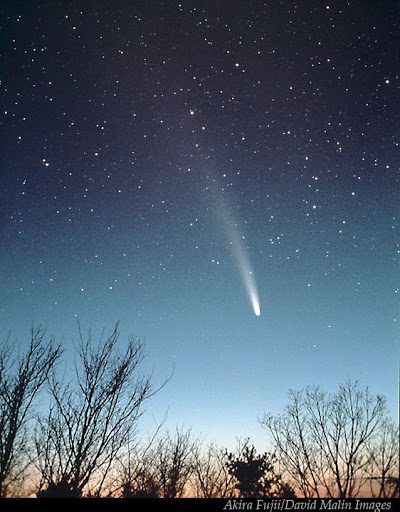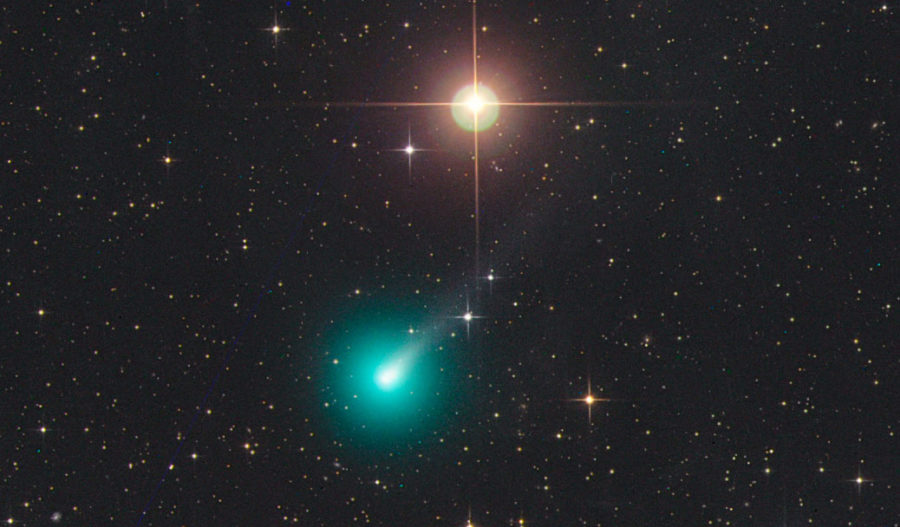One April Comet and a Manned Moon Flight Emergency

Two memorable celestial events occurred simultaneously 50 years ago this month. On the one hand there was a new and stunningly bright comet in the morning sky. Also, three Americans were once again traveling to the moon to land and explore its surface geology first hand.
In late December 1969, South African amateur astronomer John Bennett discovered what would become Comet Bennett (C/1969 Y1) which he estimated to be magnitude 8.5 – too faint to be seen with the unaided eye. The comet continued brightening and reached magnitude 0.0 (brightened by 2,500 times) with a tail about 12°long.
At that time, yours truly was a pre-teen who had heard news stories about this new comet and was determined to view it. Not knowing where to look or what to expect, I arose during pre-twilight, stepped out the front door, looked up and there it was – without a doubt! The curved comet was shining brightly high toward the north, looking like the stereotypical photos you see of bright comets. Feeling the need to share the captivating sight, I went to wake my parents. They obliged, stepping sleepily outside when they were awe struck by the spectacle. In turn, they went to wake my teen-aged sister so she could share in the wonderous sight. Her protests were heard first then she appeared, with our parents steadying and helping her out the door. Rubbing her eyes and still arguing drowsily she looked upward, instantly ceased complaining and simply exclaimed, “Wow!”
I recently found a letter online published by writer Maureen Epstein written to her parents in March, 1970. Its sense of shared family enjoyment reminded me of my own family’s experience:
“…This morning we had another memorable experience: Tony got us up at 4:30 am to see Bennett’s comet, which is visible in the east at this time. This is believed to be a new comet, and is an extraordinarily beautiful sight, with its huge tail trailing.”
–Maureen Epstein
In April of that same year Apollo 13 was launched toward the moon on a massive Saturn V rocket. The third manned moon landing and the first for 1970, the spacecraft carried commander Jim Lovell, lunar module pilot Fred Haise and command module pilot Jack Swigert. Swigert had been a member of the backup crew and had replaced Tom Mattingly who had been exposed to measles and had no natural immunity. Not wishing to have a sick crewman on a journey to the moon, NASA decided to replace Mattingly with Swigert only days before the flight.
One night, while on the way to the moon, the astronauts conducted a live television tour of the spacecraft, including the lunar module. After the broadcast, they were scheduled to turn the spacecraft toward Comet Bennett so that it could be photographed from a spacecraft window.
One last “housekeeping” chore they were given before that task was to “stir” the oxygen tanks. The oxygen was stored cryogenically as a liquid in two tanks. An embedded fan in each tank could be used to stir up the mixture to prevent settling. The problem with such stratification was that it made determining the remaining oxygen level in the tanks difficult.
I recall that on this night I was at a boy scout meeting held in a local park. They met there during warm months of the year. On pleasant evenings such as this one, the boys would stay after the meeting, playing “capture the flag” until darkness increased the risk of running full speed through the trees.
When I returned home my Father told me that there had been an explosion aboard the spacecraft. He had heard about it when a CBS News Special Report interrupted the normal broadcasting. The cause of the explosion was an electrical short circuit in the oxygen tank. A spark had caused an explosion during the tank stir.
As a child I had no doubt that the Apollo 13 astronauts would return safely. Call it faith in the adult world and/or confidence that NASA with its unflappable reputation would figure out the best way to get them back. Only over time was the sober knowledge of the true magnitude of the looming danger posed by the crippled spacecraft due to the severity of the explosion, and the absolute genius behind the all-out recovery effort, finally comprehended.
Apollo 13 returned to Earth on April 17, 1970. An investigation discovered that the oxygen tank, originally installed in Apollo 10, had been removed for modifications and accidentally dropped about two inches. It was replaced then inspected, tested and re-installed on Apollo 13, with undetected damage. Due to the resulting delay, the next moon landing by Apollo 14 did not occur until the following year.

Comet ATLAS, currently visible in our Northern Sky above Ursa Major during April and May 2020
Comets have been observed from space for decades. In the early 1970s astronauts aboard the Skylab orbiting laboratory photographed and sketched Comet Kahoutek (C/1973 E1). Several space shuttle missions observed the stupendous Comet Hale-Bopp (C/1995 O1) in the 1990s. STS-83 astronaut Donald Thomas presented a framed copy of an astrophoto he made from space of Hale-Bopp above Earth to the Westminster Astronomical Society a few years ago.
Just a post script to the Apollo story. Tom Mattingly got his chance to go to the moon two years later with Apollo 16, in 1972. In the decade of the 1980s he also traveled aboard two space shuttle missions.
–Curt Roelle
